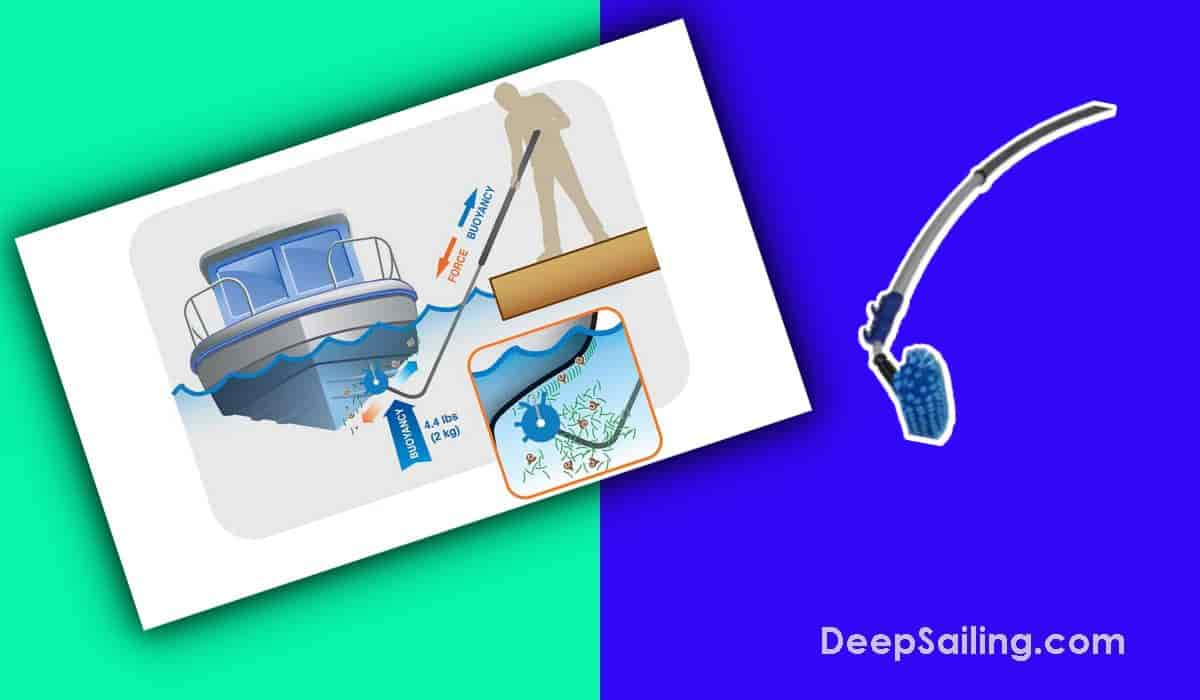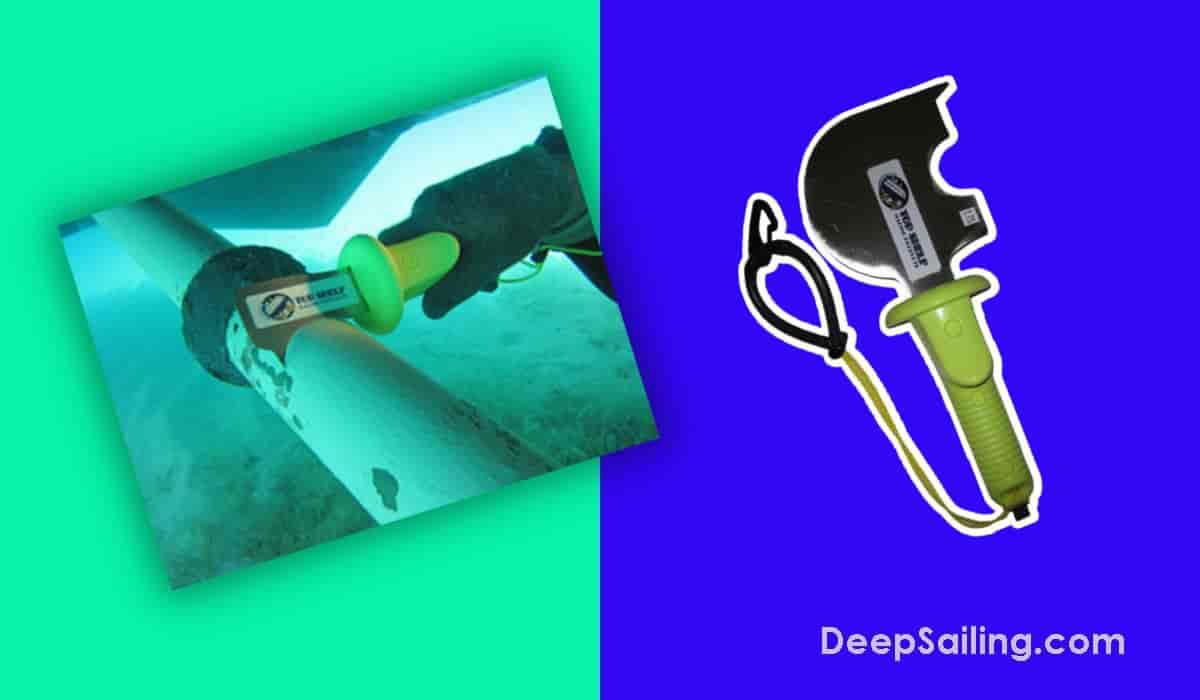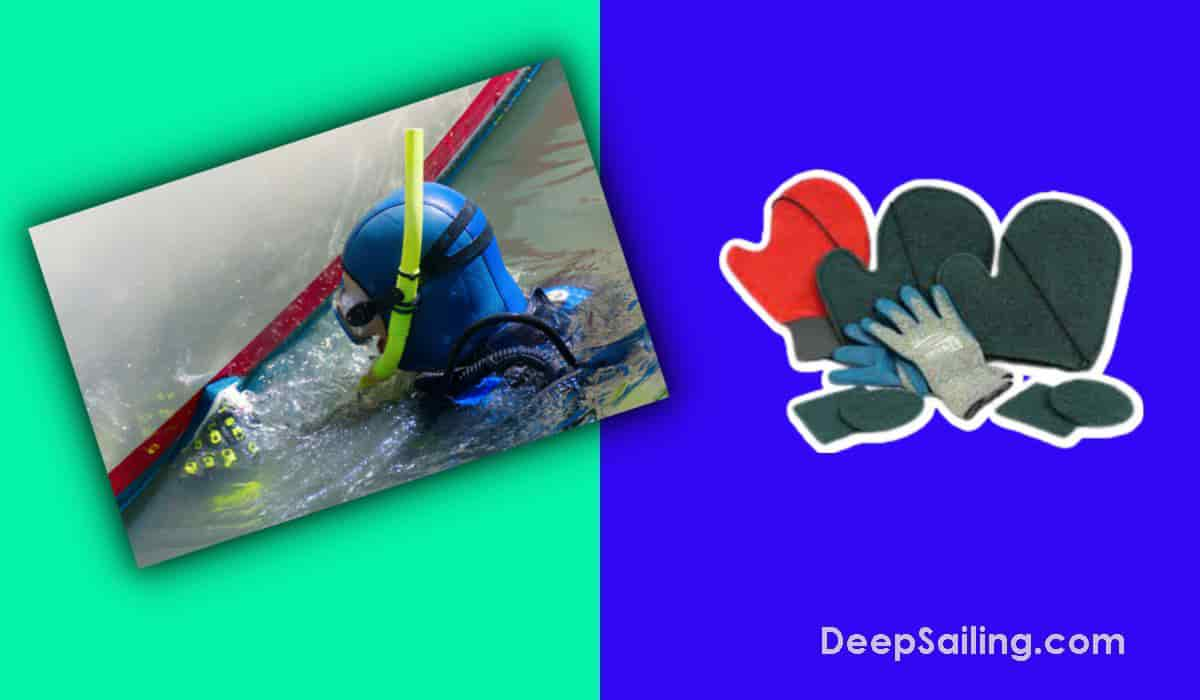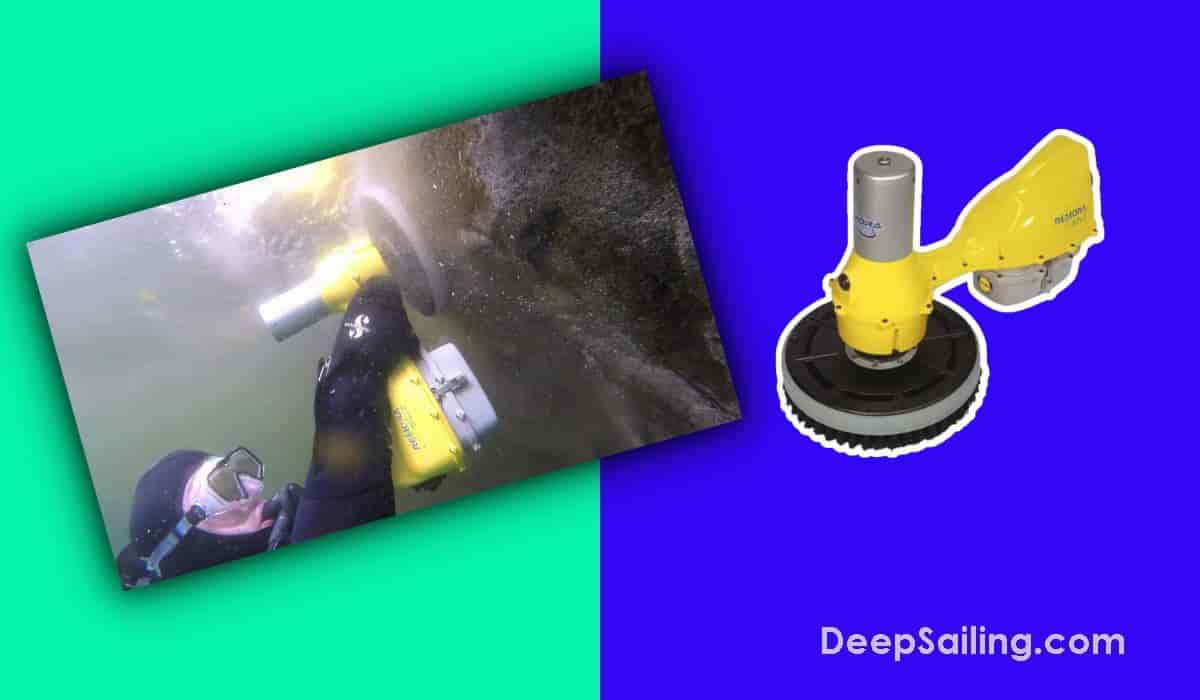Cleaning a boat's hull in the water will remove dirt, grime, barnacles, seaweed, sludge, fish blood and all dirty materials stuck to the boat's bottom underwater.
When the vessel is in the water, there are specific boat bottom cleaning methods that will clean the hull of the boat while also protecting the environment.
Marinas and local regulations mean boater owners will have to follow strict guidelines when underwater hull cleaning.
To clean a boat hull in the water:
- Scrub the boat's hull using an extended rotary brush or C pole cleaner
- Get into the water and clean more dirt with a boat hull scraper
- Scrub the underwater hull surface with hull bottom cleaning pads
- Use a motorized underwater rotary brush system to remove the deepest dirt from the hull
These are the best ways to clean the boat bottom in the water. These underwater hull cleaning instructions apply to all hull types including aluminum hulls, fiberglass hulls, wooden hulls and steel hulls, etc.
The benefits of cleaning the boat hull in the water include it improves the boat's aesthetics, stops the boat motor from overheating, prevents the boat from being slow and sluggish and helps prolong the hull condition.
According to the marine cleantech brand Scrubbis, other benefits of cleaning a boat hull in the water include it makes a boat up to 30% faster and it saves money with 20% lower operating costs.
1. Scrub The Boat Hull In The Water Using An Extended Rotary Brush

The first step in cleaning a boat hull in the water is to get an extended rotary brush and use it to scrub the underway hull.
Using an extended rotary brush is an environmentally friendly method of cleaning a boat hull in the water and it helps to protect the environment as no chemicals are used in this method of hull cleaning.
To clean the boat hull in the water using an extended rotary brush:
- Get a 12ft+ extended rotary brush: Get at least a 12ft. extended rotary brush. Ensure that the rotary brush is long enough to reach the bottom of the boat in the water
- Put the rotary brush into the water and scrub along the underwater hull: Use the extended rotary brush and its built-in buoyance to scrub the hull in the water with force. The hard bristle rotary scrub will remove hard fouling from the boat hull
- Thoroughly scrub until all the heavy fouling is removed: Use the built-in buoyancy on the extended rotary brush to help apply force and get rid of barnacles and general dirt on the hull surface
The product needed to clean the hull in the water with a rotary brush is a 12ft. or more extendable rotary brush with buoyance built in.
A C pole is another similar product to the rotary brush that is shaped like the letter "C" that can be used instead of the rotary brush.
An extendable rotary brush or C pole will cost under $100.
The product to avoid when cleaning a boat hull in the water with a rotary brush is a rotary brush that is shorter than 12ft. as this will not be long enough to reach the boat bottom.
The extended rotary brush can be used to clean a boat hull in the water from the dock, onboard a nearby dinghy or from the boat itself.
The benefits of using an extended rotary brush to clean the boat hull in the water are:
- It helps clean the hull underwater without having to get into the water
- It cleans the hull in an eco-friendly way that protects the environment with no toxic chemicals and 100% recyclable materials
- It is not expensive with a price under $100
- It removes all the dirt and improves the boat's performance
One disadvantage of using the extended rotary brush to clean the vessel's hull is it will require a lot of force and effort to really scrub the hull and get every dirty area.
Cleaning the boat hull in the water with an extended rotary brush takes approximately 40 minutes to complete for most recreational boats.
However, this timeframe will vary based on the condition and the size of the vessel with larger 50ft+ hull lengths taking over 1 hour to clean.
The majority of boat owners will clean the boat hull in the water by using an extended rotary brush and stop after this step. This step is more than enough for many boat owners.
However, some boat owners will need to do more deep hull cleaning which will involve further steps as outlined below.
2. Get Into The Water And Clean The Hull With A Boat Hull Scraper

The second step of cleaning a boat hull in the water is to get into the water and use a boat hull scraper to scrape the dirt from the hull.
Using a boat hull scraper is a method of cleaning the boat bottom in an eco-friendly way that protects the environment as no toxic chemicals are used and the material used is recyclable.
To clean a boat hull in the water using a boat hull scraper:
- Get snorkeling gear: Get snorkeling gear so you can get into the water and clean the boat bottom. This gear will include goggles, a swimsuit or diving suit and a snorkeling tube for breathing underwater
- Get a boat hull scraper: Get a heavy-duty marine-grade multi-purpose scraper that can help remove thick barnacles and dirt buildup on the boat bottom. Ideally, use a stainless-steel hull scraper than can help tackle hard dirt
- Scrape the dirt off the hull area with the scraper: Use the hull scraper to remove heavy dirt from the hull by scraping the hard fouling, seaweed, barnacles and other heavy material stuck to the hull
- Use the scraper to also scrape the boat propeller: Use the hull scraper and also scrape the boat propeller and propeller shafts to remove any heavy dirt around the propeller area of the boat
- Do not apply extreme force to the hull with the hull scraper: Do not apply extreme force to the boat hull with the hull scraper as it can remove boat paint or damage the surface
The products needed to clean the boat hull in the water using a boat hull scraper are snorkeling gear like goggles and a breathing tube, swimming trunks or a swimsuit/diving suit and a marine-grade boat hull scraper.
A boat hull scraper costs less than $50 at most retailers and snorkeling gear costs less than $60 at most retailers.
The product to avoid when cleaning a boat hull in the water using a hull scraper is a non-marine grade scraper as this will rust and erode when it is in the corrosive seawater.
The benefits of cleaning the vessel's hull underwater with a boat scraper are:
- It helps remove heavy barnacles, hard fouling and hard growth from boat hulls and boat propellers
- It is an eco-friendly way of removing hard dirt from the hull with no toxic chemicals used
- It is cheap with a price of under $50 for a hull scraper
The disadvantages of cleaning the hull using a boat scraper are it means you have to get into the water to clean the hull which doesn't suit some boat owners and it can damage the hull material/hull paint if used aggressively or forcefully on the hull surfaces.
Cleaning the boat hull in the water using a boat hull scraper takes approximately 1 hour to complete for most recreational boats.
For larger vessels over 50ft, it can take more than 90 minutes to complete.
3. Scrub The Underwater Hull Surface With Hull Bottom Cleaning Pads

The third step of cleaning a boat hull in the water is to get into the water and scrub the hull surface with hull bottom cleaning pads.
Using cleaning pads is an eco-friendly way to clean the hull in the water in a way that protects the environment as no chemicals are used.
To clean the boat hull in the water using cleaning pads:
- Get marine-grade interchangeable handle cleaning pads: Get cleaning pads with an interchangeable handle that you can use to scrub the hull surface. The interchangeable handle will make it easier to scrub and grip while underwater hull cleaning
- Use snorkeling/diving gear for cleaning underwater: Use snorkeling/diving gear so you can see and breathe underwater as you clean the vessel's bottom
- Scrub the hull surface with cleaning pads: Scrub along the underwater hull surface with the cleaning pads. Scrub in a circular motion and work in small sections to ensure every part of the hull is cleaned evenly
- Keep scrubbing the boat bottom until all the dirt is removed: Keep scrubbing the hull surface until all the dirt has been removed from the hull surface
The products needed to clean the boat hull in the water using cleaning pads are snorkeling gear like goggles and a breathing tube, swimming trunks or a swimsuit/diving suit and marine-grade interchangeable handle microfiber cleaning pads.
Marine-grade cleaning pads with an interchangeable handle costs under $30 at most retailers.
The product to avoid when cleaning the boat bottom in the water with cleaning pads is a non marine-grade cleaning pad with no handle as a cleaning pad with no handle makes it harder to grip as you scrub along the boat hull surface underwater.
The benefits of cleaning the vessel's hull underwater with cleaning pads are:
- It is eco-friendly as no toxic chemicals are used so it helps to protect the environment
- It will remove even the most stubborn dirt and fouling from the underwater boat hull surface
- It is a cheap cleaning method with cleaning pads priced under $30
- It does not damage the boat hull as cleaning pads are soft microfiber cloth that will not scratch or cause paint cracking
A disadvantage of using cleaning pads to clean a boat hull in the water is it requires a lot of elbow grease and force to thoroughly clean the hull underwater.
For most recreational boats, cleaning the boat hull in the water with cleaning pads takes approximately 45 minutes to complete.
4. Use A Motorized Underwater Rotary Brush System To Remove The Deepest Dirt From The Boat Hull

The fourth step of cleaning a boat hull in the water is to use a motorized underwater rotary brush system to remove the dirt from the hull surface.
For most boat owners, this is an optional step to clean the hull that will not be needed if the above steps are followed.
However, for larger boats or ship hulls with extreme levels of dirt, using a motorized underwater rotary brush system may be needed for cleaning.
To clean a boat hull in the water using a motorized rotary brush system:
- Get a motorized waterproof rotary brush system: Get a 21+ Ah powered waterproof rotary brush that is capable of working at deeper depths. Ideally, the rotary brush system should work at depths around 35 feet which should cover most marine hulls in the water. Ensure the motorized rotary brush system has good battery life. Typically, a minimum 2-hour battery life is needed to thoroughly clean the hull
- Get diving/snorkeling gear: Get diving gear/snorkeling gear like goggles, a breathing tube/tank and a swimsuit/diving suit. This will enable you to breathe as you clean the hull underwater
- Scrub the hull surface with the motorized rotary brush system: Apply the waterproof motorized rotary brush to the dirty underwater hull in sections. The powered rotary brush will automatically scrub the hard fouling and dirt from the hull surface. It will remove the dirt and make a noticeable difference to the surface
- Continue using the motorized rotary brush system until the entire hull is cleaned: Use the rotary brush to cover and scrub every area of the hull surface
The products needed for cleaning an underwater boat bottom with a motorized rotary brush are a 21Ah+ powered waterproof rotary brush with the capability of operating at depths of approximately 35 feet, a diving suit/swimsuit, goggles and a breathing tube/breathing tank.
A powered waterproof rotary brush system costs approximately $2,000.
The product to avoid when cleaning an underwater dirty boat bottom with a motorized rotary system is a rotary system that is not waterproof, has poor battery life and does not operate at depths lower than 20ft.
The benefits of cleaning the boat hull in the water with a motorized waterproof rotary brush system are:
- It will remove stains from the boat hull including waterline and scum line stains
- It will remove heavy fouling and barnacles from the hull
- It requires very little force or elbow grease to work effectively
One disadvantage of using the motorized waterproof rotary brush system to clean the boat bottom is it is expensive with a price tag of around $2,000.
For most recreational boats, cleaning the boat hull in the water with a motorized waterproof rotary brush system takes approximately 40 minutes to complete.
Alternative Underwater Boat Hull Cleaning Options
For boat owners that do not want to clean the boat hull in the water themselves, there are a few alternative cleaning options available.
Alternative underwater boat hull cleaning options include:
- Hiring a diver to clean the boat hull: Hiring a diver to clean the underwater hull is an alternative hull cleaning option available. This option is popular for boat owners that do not want to enter the water themselves
- Hiring a boat hull cleaning company: Hiring a professional hull cleaning company is another alternative cleaning option. This is a particularly popular cleaning option for large boats like ship hull cleaning
Hull cleaning divers or hull cleaning companies can be found online on websites like Craigslist or at your local marina.
The alternative hull cleaning options of hiring a diver or hiring a boat hull cleaning company to clean the underwater hull will typically cost between $10 and $40 per foot.
However, factors like the condition of the boat hull and the location of the boat will cause the price to vary.
Products To Use When Cleaning A Boat Hull In The Water
The products to use when cleaning a boat hull in the water are:
- 12ft+ Extended Rotary Brush: An extended rotary brush with 12-foot or more underwater reach can be used to clean the boat hull when it's in the water while you are standing on the dock
- 10-Ounce Boat Hull Scraper: The 10-ounce boat hull scraper is a heavy-duty stainless steel scraper that can be used to manually scrape dirt from a boat's hull when it's in the water
- 10ft+ C-Pole Brush: The 10ft+ aluminum C-pole is shaped like the letter C and it can reach up to 10ft+ underwater and clean the boat bottom with its attached scrub
- 21 AH Powered Rotary Brush Machine System: This is a machine-powered rotating brush that can be used underwater to clean the hull of a vessel. It can be used in depths of up to 36 feet underwater
- Microfiber Boat Bottom Cleaning Pads: These are microfiber cleaning pads that can be used to wipe along the hull while in the water
- Snorkeling Gear: Snorkeling gear is needed to be able to see the hull underwater and breathe while cleaning the hull in the water. This includes goggles and a breathing tube
We've also compiled a list of the top boat hull cleaners that can assist when cleaning the boat hull.
Products To Avoid When Cleaning A Boat Hull In The Water
The products to avoid when cleaning a boat hull in the water are:
- Bleach: Bleach can cause harm to the marine ecosystem and it should be avoided when cleaning an underwater boat hull
- Toxic cleaners: Using toxic cleaners can cause damage to the environment and it should be avoided when cleaning a boat's bottom in the water
- Non marine-grade products: Non marine-grade products should be avoided when cleaning a boat hull as they can pollute the sea water or get damaged easily due to the corrosive seawater
- Products not compatible with the hull surface: Avoid using products not compatible with a hull surface. For example, a hard bristle brush might not be a good option for fiberglass hulls as it may cause damage to the fiberglass or cause many scratches
Boat Hull Cleaning Benefits
The 7 boat hull cleaning benefits are below.
- Removes Dirt, Mildew, Barnacles, Algae & Sludge: Regular cleaning of the boat hull with the best boat hull cleaners will remove all these nasty sediments
- Improves Boat Fuel Economy: A cleaner hull helps the boat move through the sea water easier. This means less fuel is used
- Prevents Potential Hull Damage: Dirt buildup around the hull can cause damage. Regularly cleaning it will help prevent any damage caused by dirt
- Improves Boat's Appearance: Regular hull cleaning will improve the overall boat aesthetics
- Improves Overall Boat Performance: No dirt around the hull means less drag in the water. This will improve boat performance
- Saves Money On Boat Parts: Cleaning the hull frequently means you'll spot small damage before it becomes a much larger and more costly problem
- Reduces Boat Haul Outs: If the vessel is larger, hauling it out of the water can be expensive. Cleaning the hull regularly in the water reduces the need for haul-outs
Frequently Asked Questions About Cleaning A Boat Hull In The Water
Below are the most common questions about cleaning a boat's bottom in the water.
How Often Should A Boat Hull Be Cleaned?
A boat hull should be cleaned between once every 3 months and once every 6 months.
What Are The Rules To Follow When Cleaning A Boat Hull In The Water?
The rules to follow when cleaning a boat hull in the water are:
- Ensure the boat power is completely turned off: Before entering the water to clean the boat bottom, ensure that all power has been switched off. This includes electronics, motors and propeller power
- Ensure there is a second person with you when cleaning the hull: Ensure there is a second person with you when cleaning the hull underwater as the second person can alert you to any potential issues when you are in the water
- Follow the marina and marine rules and regulations: Ensure you follow both the local marina rules and the marine rules when cleaning a boat hull in the water. Your local marina will provide you with local information specific to your area regarding cleaning a hull in the water. For example, one regulation you will need to follow is the Clean Water Act. The Clean Water Act is a U.S. federal law that regulates the discharge of pollutants into the water
- Do not clean the hull in the water if you cannot swim: If a boat owner cannot swim, they should not get into the water to clean the hull. Instead, use an extended rotary brush that can be used from the dock itself to clean the hull without the need for the owner to enter the water or alternatively, hire professional divers to do the cleaning
What Is The Cost Of Cleaning A Boat Hull?
The approximate cost to get a boat hull cleaned ranges from $2 to $8 per foot. This is the price range based on a boat that is out of the water.
How Often Should A Boat Hull Be Cleaned?
A boat's hull should be cleaned on average between once every 3 months to once every 6 months.